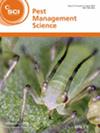求助PDF
{"title":"Construction of a beneficial microbes-enriched rhizosphere system assists plants in phytophagous insect defense: current status, challenges and opportunities.","authors":"Zhongwang Liu, Yihan Xia, Jinfang Tan, Mi Wei","doi":"10.1002/ps.8305","DOIUrl":null,"url":null,"abstract":"<p><p>The construction of a plant rhizosphere system enriched with beneficial microbes (BMs) can efficiently help plants defend against phytophagous insects. However, our comprehensive understanding of this approach is still incomplete. In this review, we methodically analyzed the progress made over the last decade, identifying both challenges and opportunities. The main methods for developing a BMs-enriched rhizosphere system include inoculating exogenous BMs into plants, amending the existing soil microbiomes with amendments, and utilizing plants to shape the soil microbiomes. BMs can assist plants in suppressing phytophagous insects across many orders, including 13 Lepidoptera, seven Homoptera, five Hemiptera, five Coleoptera, four Diptera, and one Thysanoptera species by inducing plant systemic resistance, enhancing plant tolerance, augmenting plant secondary metabolite production, and directly suppressing herbivores. Context-dependent factors such as abiotic and biotic conditions, as well as the response of insect herbivores, can affect the outcomes of BM-assisted plant defense. Several challenges and opportunities have emerged, including the development of synthetic microbial communities for herbivore control, the integration of biosensors for effectiveness assessment, the confirmation of BM targets for phytophagous insect defense, and the regulation of outcomes via smart farming with artificial intelligence. This study offers valuable insights for developing a BM-enriched rhizosphere system within an integrated pest management approach. © 2024 Society of Chemical Industry.</p>","PeriodicalId":218,"journal":{"name":"Pest Management Science","volume":null,"pages":null},"PeriodicalIF":3.8000,"publicationDate":"2024-07-10","publicationTypes":"Journal Article","fieldsOfStudy":null,"isOpenAccess":false,"openAccessPdf":"","citationCount":"0","resultStr":null,"platform":"Semanticscholar","paperid":null,"PeriodicalName":"Pest Management Science","FirstCategoryId":"97","ListUrlMain":"https://doi.org/10.1002/ps.8305","RegionNum":1,"RegionCategory":"农林科学","ArticlePicture":[],"TitleCN":null,"AbstractTextCN":null,"PMCID":null,"EPubDate":"","PubModel":"","JCR":"Q1","JCRName":"AGRONOMY","Score":null,"Total":0}
引用次数: 0
引用
批量引用
Abstract
The construction of a plant rhizosphere system enriched with beneficial microbes (BMs) can efficiently help plants defend against phytophagous insects. However, our comprehensive understanding of this approach is still incomplete. In this review, we methodically analyzed the progress made over the last decade, identifying both challenges and opportunities. The main methods for developing a BMs-enriched rhizosphere system include inoculating exogenous BMs into plants, amending the existing soil microbiomes with amendments, and utilizing plants to shape the soil microbiomes. BMs can assist plants in suppressing phytophagous insects across many orders, including 13 Lepidoptera, seven Homoptera, five Hemiptera, five Coleoptera, four Diptera, and one Thysanoptera species by inducing plant systemic resistance, enhancing plant tolerance, augmenting plant secondary metabolite production, and directly suppressing herbivores. Context-dependent factors such as abiotic and biotic conditions, as well as the response of insect herbivores, can affect the outcomes of BM-assisted plant defense. Several challenges and opportunities have emerged, including the development of synthetic microbial communities for herbivore control, the integration of biosensors for effectiveness assessment, the confirmation of BM targets for phytophagous insect defense, and the regulation of outcomes via smart farming with artificial intelligence. This study offers valuable insights for developing a BM-enriched rhizosphere system within an integrated pest management approach. © 2024 Society of Chemical Industry.
构建富含有益微生物的根瘤菌系统,协助植物防御植食性昆虫:现状、挑战与机遇。
构建一个富含有益微生物(BMs)的植物根瘤层系统可以有效地帮助植物抵御植食性昆虫。然而,我们对这种方法的全面了解仍不全面。在这篇综述中,我们有条不紊地分析了过去十年取得的进展,指出了挑战和机遇。开发富含生物微生物的根瘤菌圈系统的主要方法包括将外源生物微生物接种到植物中、用改良剂改良现有的土壤微生物群以及利用植物塑造土壤微生物群。生物微生物可以通过诱导植物系统抗性、增强植物耐受性、提高植物次生代谢物产量以及直接抑制食草动物等方式,帮助植物抑制植食性昆虫,包括 13 种鳞翅目昆虫、7 种同翅目昆虫、5 种半翅目昆虫、5 种鞘翅目昆虫、4 种双翅目昆虫和 1 种鞘翅目昆虫。非生物和生物条件以及昆虫食草动物的反应等环境因素会影响 BM 辅助植物防御的结果。目前出现了一些挑战和机遇,包括开发用于控制食草动物的合成微生物群落、整合生物传感器进行效果评估、确认植物食草昆虫防御的生物媒介目标,以及通过人工智能智能农业调节结果。这项研究为在病虫害综合防治方法中开发富含生物分子的根瘤菌圈系统提供了宝贵的见解。© 2024 化学工业协会。
本文章由计算机程序翻译,如有差异,请以英文原文为准。


 求助内容:
求助内容: 应助结果提醒方式:
应助结果提醒方式:


